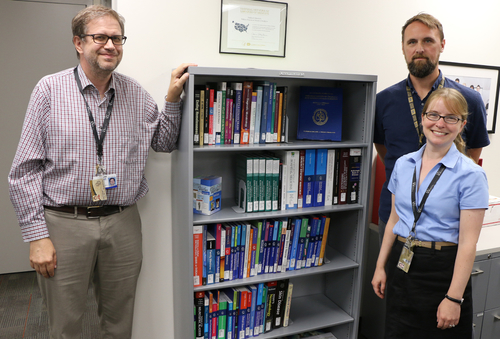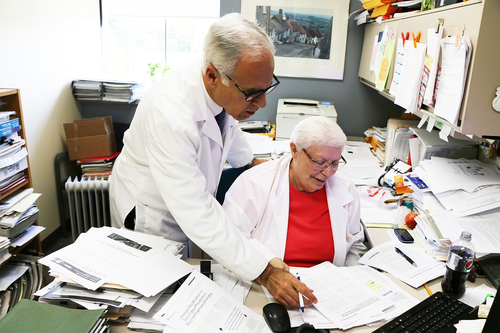
Faculty, students, and staff at Oakland University William Beaumont School of Medicine have been published more than 5,000 times since 2011 — a significant milestone for the school that had a total of about 30 its first year.
Nancy Bulgarelli, director, OUWB Medical Library, said the 5,000-mark was surpassed during the 2018-19 school year.
The total figure includes 647 OUWB-related publications from last year, according to the library’s recently released “Publications List by Department: 2018 Preliminary Report.” By comparison, the school had a total of 32 citations in 2011.
“I think it speaks highly of the medical school, and highly of the talent that they’ve recruited,” said Barry Franklin, M.D., director, Preventive Cardiology and Cardiac Rehabilitation, Beaumont Health, Royal Oak, and professor, Internal Medicine, OUWB. Franklin has been published more than 700 times.
Bulgarelli, OUWB Medical Library director since the school’s founding, said it’s important to keep track of the work done by faculty, students, and staff, but that it’s not just about the numbers.
“Our people are publishing in a wide variety of good, quality journals — they’re getting their work out there and that’s what’s important,” Bulgarelli said.
Monitoring publications
Most publications are in medical journals, though the library also counts books and book chapters.
“The fundamental way that scientific discoveries are communicated are through peer-reviewed scholarly articles,” Bulgarelli said. “They advance scientific knowledge and scholarship.”
Generally speaking, there are five common types of articles:
- Research articles report the results of research studies on a range of topics varying from the basic mechanisms of diseases to clinical trials that compare outcomes of different treatments.
- Review articles summarize and analyze the information available on a specific topic based on a careful search of the medical literature.
- Case conferences and case reports may be published in medical journals to educate clinicians about particular illnesses and treatments.
- Editorials in medical journals are short essays that express the views of the authors, often regarding a research or review article published in the same issue.
- Letters to the editor provide a way for readers of the medical journal to express comments, questions, or criticisms about articles published in that journal. Short research reports and case reports may also be published as letters to the editor.
Being published is a rigorous process, Bulgarelli said, one that typically involves a lot of research, writing, a blind review by peers (if applicable), and ultimately, acceptance for publication (never guaranteed).
“It is not easy,” she said. “Especially in some of the top tier journals.”
Because articles that do get published list the author or authors and their respective institutional affiliations, OUWB’s medical library staff is able to track just about anything authored or co-authored by people with OUWB connections.
The library keeps track of these types of articles largely by monitoring medical industry sources online like Medline, PubMed, Scopus, Web of Science, EMBase, CINAHA, MedEd Portal and Springernet.
Popular publications for OUWB-related authors include: Neurourology and Urodynamics, American Journal of Emergency Medicine, American Journal of Clinical Oncology, American Journal of Surgery, and more.
Bulgarelli said finding and recording publications has evolved into a full-time job, and she recalls, with a big smile, how exciting it was when the very first OUWB-related publications appeared in 2011.
“We started seeing things popping up with OUWB and it was like ‘Oh, we’re real!’” Bulgarelli said.
Not just about the numbers
According to the American Medical Association, publication in a journal does more than just improve resume. It also gives authors the chance to share ideas and experiences, educate others, and establish themselves as experts.
With more than 700 publications (papers, book chapters, and 27 books), Franklin is one of the most prolific authors with a connection to OUWB.
 “Occasionally, you get an email or call from somebody around the world saying ‘I read your piece on how to treat patients with cardiovascular disease and we’re adopting your procedures, am I correct in this, that, or the other thing?’” Franklin said. “To me, that’s extremely satisfying — once you get into literature you can impact care of people all over the world. It’s a legacy that I’ll leave.”
“Occasionally, you get an email or call from somebody around the world saying ‘I read your piece on how to treat patients with cardiovascular disease and we’re adopting your procedures, am I correct in this, that, or the other thing?’” Franklin said. “To me, that’s extremely satisfying — once you get into literature you can impact care of people all over the world. It’s a legacy that I’ll leave.”
Franklin said there are other reasons for wanting to be published.
“The second thing that really excites me is working with a fellow, or resident on their first paper, their first abstract at a national meeting where they’re standing by a poster, and I helped them put it together,” he said.
Being published can also open other kinds of doors. Within the last two years, Franklin has been invited to participate in significant medical events held in China and Italy — both as a direct result of work he’s published.
Franklin also said he believes quality publications can go much further than traditional forms of advertising in establishing reputation and awareness of an institution like OUWB.
“I do believe the more visibility you have — whether it’s for OUWB, Beaumont, or both — the more opportunities you’re going to have,” he said.
Students find success, too
In addition to faculty members, Bulgarelli said the number of students getting published is “amazing.”
“It tells me we are providing our students with a lot of opportunity, and that they’re getting a lot of support from the OUWB faculty and other people at Beaumont,” she said, adding that getting published as a student not only looks good on a resume but can help land a residency.
M4 Ramitha Nyalakonda was the primary author on an article called “A Teenage Female with Transient Dysarthria, Pallor, and Petechiae,” which was published in the May issue of Clinical Pediatrics.
“In order to get published, I noticed that it's not just an individual effort, but more of a group effort,” said Nyalakonda.
It’s a notion shared by Franklin, who said he never would have been published so much without the support of others at Beaumont, including Brenda White, his administrative assistant. White assists with transcribing Franklin’s writing (his original drafts are handwritten in pencil), as well as research.
Nyalakonda said she received a tremendous amount of support from her attending physician, Brian Berman, M.D., chairman, Department of Pediatrics, Beaumont Health, and pediatrician-in-chief, Beaumont Children's.
According to Nyalakonda, Berman spent “countless hours” looking over her drafts and helping her learn from missteps along the way. Nyalakonda said the level of support she received helped her feel comfortable submitting a final version for publication.
“I wanted to get published in order to learn how to conduct research individually, and learn about the process,” she said. “It's important to always be updated on the latest remedies, treatments…for patient care, and research will always be one of the best methods to do so.
“It felt great to have my article published,” she added. “I put in a lot of time and effort into working on this article, and seeing it in print definitely made everything worth it.”
For more information, contact Andrew Dietderich, marketing writer, OUWB, at [email protected].

